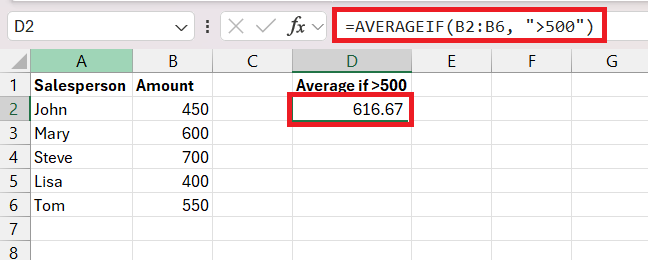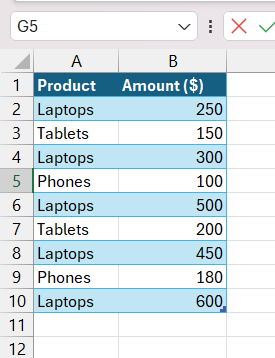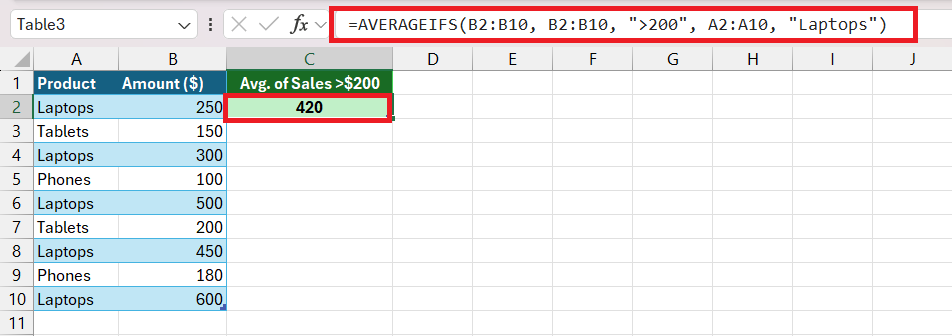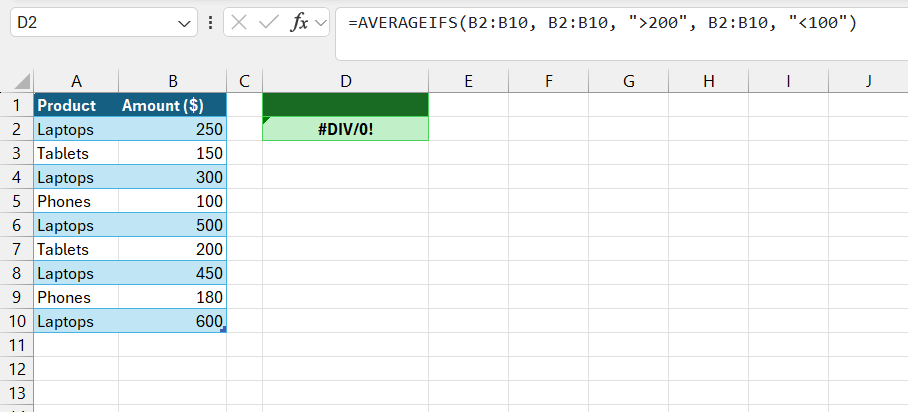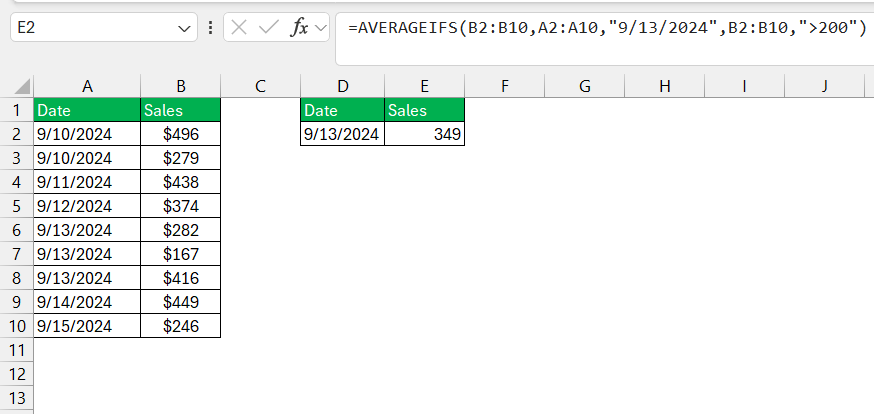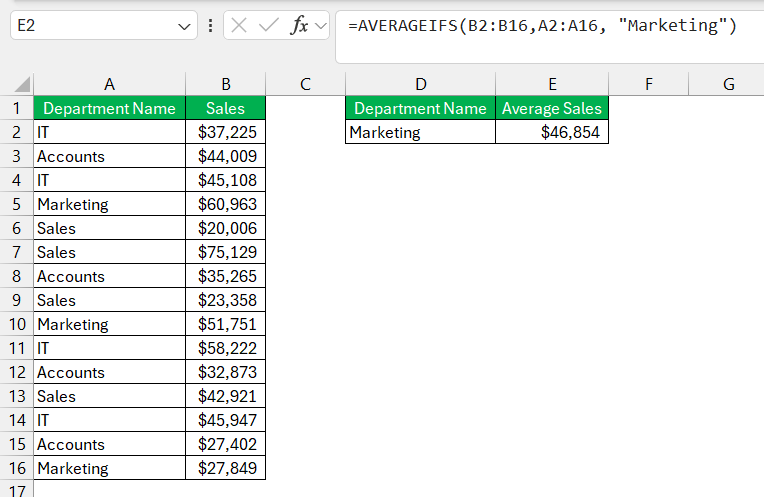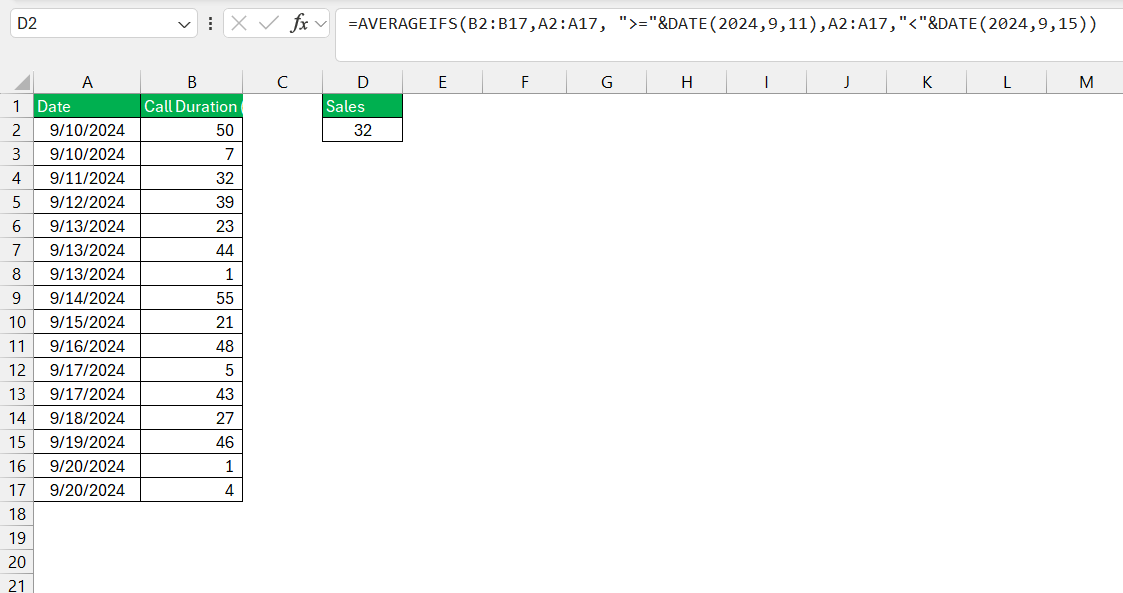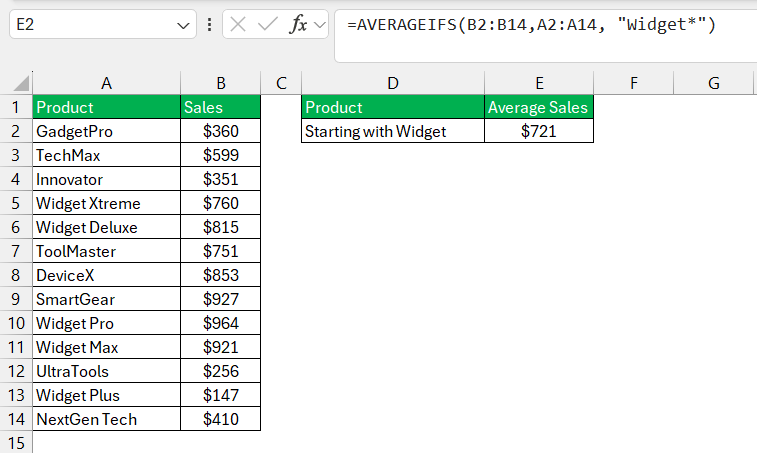The AVERAGEIFS function in Excel is a powerful tool for calculating the average of values in a range based on multiple criteria. This function helps users perform more sophisticated data analysis by applying several conditions simultaneously to refine their results. Whether you’re analyzing sales data or tracking performance metrics, AVERAGEIFS enables precise and flexible computations tailored to your specific needs.
Key Takeaways:
- Versatile Averaging: AVERAGEIFS averages values based on multiple conditions, ideal for complex data analysis.
- Simple Syntax: Use =AVERAGEIFS(average_range, criteria_range1, criteria1, [criteria_range2, criteria2], …) and ensure criteria ranges match in size.
- Precision: Match criteria types with data, use logical operators correctly, and format dates properly.
- Practical Uses: Useful for tasks like calculating average salaries by department or average call times.
- Wildcard Support: Wildcards (* and ?) enable flexible averaging with partial text matches.
Table of Contents
Getting Started with AVERAGEIFS
Introducing the Power of AVERAGEIFS in Excel
I’ve often found that the best way to manage large datasets in Excel is by effectively utilizing its built-in functions. The AVERAGEIFS function stands out as particularly powerful when you’re dealing with data that require condition-based analysis.
Imagine you’re analyzing a spreadsheet full of sales data, and you need to find the average revenue, but only for a specific product and only when the sales exceed a certain number. That’s where AVERAGEIFS comes in—it can seamlessly handle multiple conditions, making your task not only possible but straightforward.
By using AVERAGEIFS, you ensure that your data analysis is both accurate and efficient, allowing you to glean insights that might otherwise be lost in the breadth of raw data.
Navigating the Basic Syntax and Parameters
Navigating the terrain of Excel formulas can at times seem daunting, but AVERAGEIFS is quite approachable once you understand its syntax and parameters. The basic structure of AVERAGEIFS is: =AVERAGEIFS(average_range, criteria_range1, criteria1, [criteria_range2, criteria2], ...). Let’s break it down:
- average_range: The set of cells you want to average.
- criteria_range1: The range where the first condition should be evaluated.
- criteria1: The condition that must be met by criteria_range1.
- And you can continue adding criteria ranges and corresponding criteria as needed.
One of the key things to remember is that your criteria_ranges need to be the same size and shape. They’re like puzzle pieces that need to fit together to give you the true picture of your data.
Let’s check with an example where you have sales data for different types of products and different sales amounts. You want to calculate the average sales amount for “Laptops” where the sales amount is greater than $200:
STEP 1: Add relevant data to respective rows and columns.
STEP 2: In C2 type in the following “=AVERAGEIFS(B2:B10, B2:B10, “>200”, A2:A10, “Laptops”)” to find the average sales amount for “Laptops” where the sales amount is greater than $200. And check the result.
Explanation:
B2:B10is the range from which to calculate the average (Amount).B2:B10is the range to check for the first criterion (Sales Amount > 200).">200"is the criterion for the sales amount.A2:A10is the range to check for the second criterion (Product = “Laptops”)."Laptops"is the criterion for the product.
Keep in mind that these criteria can be numbers, expressions, or text that define which cells will be included in the average calculation. By getting the hang of these basics, you are setting yourself up for success in deeper data analysis with Excel.
Harnessing AVERAGEIFS for Data Analysis
Crafting Criteria: Tips for Accuracy and Precision
When it comes to crafting criteria for AVERAGEIFS, precision is the game-changer. Here’s what I’ve learned to ensure accuracy:
- Match Criteria Types: Ensure that the criteria you specify match the data types in the criteria ranges. If you’re averaging based on text criteria, use quotes around the text.
- Utilize Logical Operators: For numeric criteria, use logical operators like
>,<,>=,<=,<>. For example,">500"means average only those cells greater than 500.
- Avoid Overlap and Conflict: Ensure your conditions don’t create overlaps or conflict with each other, as this could lead to unexpected results or errors.
- Date Criteria: Often overlooked, but dates need to be in the date serial number format that Excel recognizes or in quotation marks if you’re using a date directly in a formula.
By adhering to these tips, you promote not just mere functionality but precision in your use of AVERAGEIFS, gleaning even the subtlest insights from your datasets.
Real-World Applications of AVERAGEIFS
Achieving Departmental Benchmarks: Average Salary Cases
In the realm of human resources, achieving departmental benchmarks regarding average salaries can be insightful for maintaining competitive compensation packages and fostering equity within a company. Using AVERAGEIFS, we can calculate an average salary by department with precision, which is crucial for strategic financial planning and employee satisfaction.
For example, to determine the average salary within a specific department, the AVERAGEIFS function is the tool of choice. We set the average_range to the salary column and establish criteria such as the department name within another column. The function would look something like this: =AVERAGEIFS(salaries_range, departments_range, "Marketing"). This simplifies an otherwise grueling task, particularly in large organizations where departmental differentiation is a must.
The benefits of this function in real-world salary analysis are numerous—promoting transparency, aiding in budget forecast, optimizing staffing levels, and most importantly, it supports fair pay practices by making discrepancies visible for corrective action.
An interesting angle would be to talk about potential biases in data collection and the important role accurate sorting and identification of departments play in achieving meaningful results when calculating these averages.
Time Tracking Made Simple: Calculating Average Call Times
In industries reliant on customer support, understanding call times can be pivotal for operational efficiency. I often recommend Excel’s AVERAGEIFS function for calculating average call times as it simplifies what could otherwise be a complex process into something manageable.
Imagine having a worksheet with the dates of calls in one column and their durations in another. Lacing together AVERAGEIFS, one can specify average call time for any particular month, or even day, by setting the corresponding date as a criterion. The added strength comes with AVERAGEIFS’s ability to exclude outliers, like missed calls, by setting a minimum call duration as an additional condition.
The formula might look like this: =AVERAGEIFS(call_duration_range, date_range, ">="&DATE(2024,9,11), date_range, "<"&DATE(2024,9,15)).
The efficiency gained in using AVERAGEIFS for this purpose not only saves time but also allows for real-time monitoring and improving customer service metrics. It’s a technique that can be easily adapted to match any time-tracking needs across various fields, from support center call times to time spent on projects in a corporate setting.
Advanced Techniques with AVERAGEIFS
Utilizing Wildcards for Flexible Averaging
When it comes to Excel, flexibility often lies in the tiniest of symbols—wildcards. Wildcards serve a special purpose, particularly in AVERAGEIFS, where they can be a savior by allowing for partial matches in text-based criteria. They add a layer of elasticity that can adapt to various text patterns, making the function incredibly versatile.
For instances where we need to average numbers based on a text string that might not be an exact match, we can use the asterisk (*) to represent any number of characters and the question mark (?) to represent any single character. This is exceptionally useful when dealing with inconsistent data entries.
For a more concrete example, let’s say you’re tasked with averaging sales figures for products that have multiple variants. By using an asterisk in your criteria, =AVERAGEIFS(sales_range, product_range, "Widget*"), you could easily calculate an average that includes all products that start with the word “Widget” regardless of what follows.
Don’t forget the escape character tilde (~) for the times when you need to search for an actual question mark or asterisk in your data. It strips the wildcard characters of their special abilities, treating them like any other character.
By harnessing wildcards in AVERAGEIFS, we tap into the potential to average across datasets with non-uniform text entries—making it a straightforward affair rather than a complicated mess.
FAQs
How do you use the averageifs function in Excel?
To use AVERAGEIFS in Excel, you craft a formula that specifies a range of cells to average (average_range) and pairs of ranges and their associated criteria (criteria_range1, criteria1, etc.) that determine which cells to include in the average. The syntax is: =AVERAGEIFS(average_range, criteria_range1, criteria1, [criteria_range2, criteria2], ...). Make sure all criteria ranges are the same size and shape as the average_range, and use logical operators and text qualifiers properly within the criteria.
What Are the Most Frequent Use Cases for AVERAGEIFS?
Some of the most frequent use cases for AVERAGEIFS include analyzing business data like computing the average sales for specific periods or under certain conditions, calculating average grades or test scores for designated student groups, and in finance, averaging transaction amounts that fall within specified budgetary constraints. It’s also commonly used to monitor performance metrics, such as average response times in customer service provided certain criteria are met.
How Can I Use AVERAGEIFS with Non-Numerical Data?
For non-numerical data, AVERAGEIFS can be used to average numerical data that corresponds to specific text or date criteria. You can set text-based conditions (like a department name) to average numbers associated with that text. With dates, you can average figures within a specified timeframe. Remember, the function averages numbers but uses non-numerical data to define conditions.
Are There Any Limitations to the AVERAGEIFS Function?
Yes, AVERAGEIFS has limitations. It only accepts ranges that are the same size and shape. Text criteria must be an exact match, unless using wildcards, and it doesn’t support 3D ranges or average across multiple sheets. Additionally, overly complex criteria can impact calculation speed, and it’s limited to Excel 2007 and later versions.
What is the difference between Averageif and Averageifs in Excel?
The difference between AVERAGEIF and AVERAGEIFS is in the criteria allowance. AVERAGEIF is designed to calculate the average for a range based on a single condition. In contrast, AVERAGEIFS allows for averaging cells that meet multiple criteria. So, AVERAGEIFS can perform more complex conditional averaging, adapting to datasets that require multiple conditions to define the desired subset for averaging.
John Michaloudis is a former accountant and finance analyst at General Electric, a Microsoft MVP since 2020, an Amazon #1 bestselling author of 4 Microsoft Excel books and teacher of Microsoft Excel & Office over at his flagship MyExcelOnline Academy Online Course.

